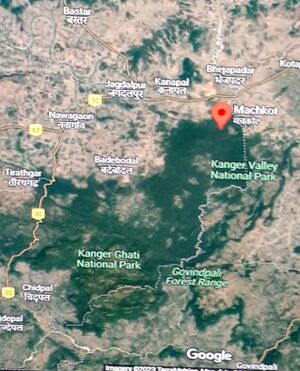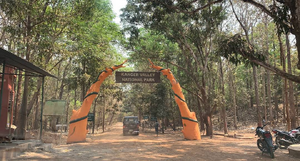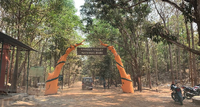Kanger Valley National Park
| Author:Laxman Burdak, IFS (R) |
Kanger Valley National Park (also known as Kanger Ghati National Park) is a national park in the Bastar region of Chhattisgarh state in India. It came into existence in July 1982 and covers an area of approximately 200 square kilometres.
Variants
Location
The park extends from the Teerathagarh waterfalls in the west to the Kolab river (Odisha state boundary) in the east, spanning an average length of 33.5 km and an average width of 6 km from north to south. It derives its name from the Kanger river, which flows centrally through it. Situated at a distance of 30 km southeast of Jagdalpur city, it is one of India's densest national parks and is known for its biodiversity, landscape, waterfalls, and subterranean geomorphologic limestone caves. It is also the home to the Bastar hill myna, the state bird of Chhattisgarh.[1]
The park is noted for its highly heterogeneous land formations, from low, flat areas to steep slopes, plateaus, valleys, and stream courses. Its vast, undulating terrain harbours habitats for diverse flora and fauna. It has a sizable tribal population, and is a popular destination for hikers, wildlife enthusiasts and researchers.
Flora and fauna in the park
Flora: The flora in the park consists chiefly of mixed moist deciduous type of forests with predominance of sal, teak and bamboo trees. In fact, the Kanger Valley is the only region in the Peninsular India where one of the last pockets of virgin and untouched forests are still left.[2]
According to the survey done by the Botanical Survey of India and other research organizations, the national park has 553 floral species out of which 12 species are new to Chhattisgarh; 43 species are reported rare.
Floral diversity includes in situ gene bank of medicinal plants, grasses, climbers, wild sugarcane, canes, ferns, epiphytes, Sal, teak, bamboo and their rich associates.
Fauna: The blind and albinic cavefish (Indoreonectes evezardi) from Kotumsar Cave, India Major wildlife of the Kanger Valley National Park are tigers, leopards, mouse deer, wild cat, chital, sambar, barking deer, jackals, langurs, rhesus macaque, sloth bear, flying squirrel, wild boar, striped hyena, rabbits, pythons, cobra, crocodiles, monitor lizards and snakes. The avian fauna at the park includes hill myna, spotted owlet, red jungle fowl, racket-tailed drongos, peacocks, parrots, steppe eagles, red spurfowl, phakta, bhura teeter, tree pie and heron among many others.
A few tributaries form marshy land in early dry season due to natural seepage. Ekta Jhodi, Kyam nullah, Karanji Jhodi, Rajamunda, Punji Jhodi, Komkel Jhodi forms good marshy areas which are good habitat of wild boar and sloth bear. Chital, barking deer, and panther are mainly found in this marshy area. Kariya Ama Nallah is a perennial marshy belt and is ideal habitat for the wild boar, sloth bear, chital, leopard and tiger.
Human settlements in the park and adjoining areas
The national park comprises two ranges viz: Kotamsar and Koleng Ranges. The Kotamsar Range, forming the western half on the park is dotted with revenue villages on its boundary and there is hardly any forest area outside the park for fuel wood, small wood, bamboo and other non-timber forest produce. So the Zone of Influence (Zl) for people in this range is 10 km. The Koleng Range forming the eastern half of the park has a lesser number of villages on its boundary and is comparatively free from biotic pressure. So in the central portion Zone of Influence is 10 km and on eastern boundary it is 5 km. All together there are 48 villages within 5 km radius of national park boundary and only one forest village (Kotamsar) is inside the national park.[3]
Kanger River
Kanger River is among very few perennial rivers of Bastar, and herein lies the importance of the river and the park. Kanger River is a lifeline and hills are its recharging reservoir; the whole national park is the catchment of Godavari River.
Limestone caves
The Kanger Valley National Park has huge limestone deposits where some of them are in the form of caves and the rest of it are in the form of layers or beds one upon the other. These deposits are present above the soil as well as under the ground level. The underground portions form the caves.
The national park is known for the long subterranean geomorphological limestone caves and is a major tourist attraction in the region. All limestone caves are present north of Kanger River between Madarkonta and Kodri Bahar. These are Kotamsar cave, Kailash Cave, Dandak Cave, Devgiri Cave. Many other caves were also discovered in the national park. These caves have very fine structures of dripstones i.e. stalactites and stalagmites. Chemically these formations are recrystallized calcium carbonate. These structures have taken million of years to form.
Kotamsar and Kailash caves are opened for tourists and other caves are closed for tourists. Only those caves which have openings have been discovered in the National park. There are many caves which have no opening and they are yet to be discovered.
Kailash Caves: Kailash Caves are located in the Kanger Valley National Park area near Mikulwada. The caves are located around 40 km from Jagdalpur. Discovered recently in 1993, the caves are around 250 meters long and are situated at an altitude of 40 meters above the ground level. It features stalactite and stalagmite formations.
Access to the cave is through a narrow opening and at the end of the cave is a huge stalagmite formation in the shape of Shivlinga. The hollow walls of the cave, when struck by hand, make musical sounds.[4]
Bhainsa Darha: Bhainsa Darha is located at a distance of 65 km from Jagdalpur. Kanger river is full of deep gorges so darha (water pools) maintain very hygienic quality of water. Crocodiles are mainly found in these darhas.
It is surrounded by mountains with thick greenery from all sides. The watch tower situated at Bhainsa Darha overlooks the lake. Bhainsa Darha lake has crocodiles and tortoises.
Kanger Dhara: Kanger Dhara is located inside the Kanger Valley National Park, 36 km from Jagdalpur.
Being in the laps of Kanger Valley, Kanger Dhara waterfalls is actually produced by the Kanger River due to presence of undulating rocks present there. Geologists suggest that the area was a sedimentary terrain, later intruded by Igneous rock bodies, due to which, the area has got such folded structures.
Just at the beginning of the downstream of Kanger river, when the river falls from undulating folded rocks, it presents a view of small cascades of water fall, which forms the Kanger Dhara.
Dandak Cave: Similar to Kotumsar Cave, one can see the stalactites and stalagmites.
Places to visit
The routes prescribed for tourism in the national park as follows:
- Kotamsar Barrier to Kotamsar (5 km)
- Kotamsar Barrier to Kanger Dhara (7 km)
- Kotamsar Barrier to Kotamsar cave (10 km)
- Tirathgarh barrier to Tirathgarh waterfalls (7 km)
- Netanar barrier to Kailash cave (5 km)
- Nature trail from Kamanar barrier to Tirathgarh waterfalls (3.0 km)
- Nature trail from Kailash cave to Kailash zheel (1.5 km)
How to reach the park
Kanger Valley is well approachable from Jagdalpur in the Chhattisgarh state of India as can be seen on the road network map of the area.
Entry into the national park is permitted form Netanar and Kotamsar barriers. Netanar barrier is situated at 33 km from Jagdalpur on the road passing through village Sargipal, Bodal, Murma, and Netanar. The park starts after 3 km from the Netanar barrier. Main entry of the park is from Kotamsar barrier situated at 27 km from Jagdalpur on the Jagdalpur-Darbha road i.e. NH 221 (connecting Jagdalpur to Vijayawada in Andhra Pradesh). Inside the park there is good network of Murram and Kutcha roads
कांगेर घाटी राष्ट्रीय उद्यान
कांगेर घाटी राष्ट्रीय उद्यान - कांगेर घाटी राष्ट्रीय उद्यान छत्तीसगढ प्रान्त के बस्तर जिले में स्थित है। प्रकृति ने कांगेर घाटी को ऐसा उपहार सौंपा है, जहाँ वन देवी अपने पूरे शृंगार में मंत्रमुग्ध कर देने वाली दृश्यावलियों को समेटे, भूमिगार्भित गुफाओं को सीने से लगाकर यूं खडी होती है मानो आपके आगमन का इंतजार कर रही हो। कांगेर घाटी का दर्शन एक संतोषप्रद, अवर्णनीय एवं बेजोड प्राकृतिक अनुभव का उदाहरण है। कांगेर घाटी राष्ट्रीय उद्यान जगदलपुर से मात्र 27 किमी की दूरी पर स्थित है। रायपुर जिले से लगभग 330 किमी की दूरी पर है। यह उत्तर पश्चिम किनारे पर तीरथगढ जलप्रपात से प्रारंभ होकर पूर्व में उड़ीसा की सीमा कोलाब नदी तक फैला है। कांगेर नदी इसके बीचों-बीच इठलाती हुई चलती है। इसकी औसत चौड़ाई 6 किमी एवं लम्बाई 48 किमी है। इसका क्षेत्रफल 200 वर्ग किमी है। इसकी सीमा 48 गाँवों से घिरी है।
जीवमंडल रिजर्व: बस्तर में प्रकृति के इस उपहार को संरक्षण के लिए आरक्षित अनोखे वन को जुलाई 1982 में कांगेर घाटी राष्ट्रीय उद्यान घोषित किया गया। इसके अनछुये एवं कुंवारे वनों के सौंदर्य को देखकर इसे जीवमंडल (बायोस्फियर) रिजर्व भी घोषित किया गया है। आरक्षित वन घोषित करने का उद्देश्य जंगल एवं इसके प्राकृतिक मृतप्राय घटको को पुनर्जीवित कर हर हालत में इसे सुरक्षा प्रदान कर, वन्य प्राणियों के लिए उपयुक्त शरण स्थल प्रदान करना था एवं प्रकृति प्रेमियों एवं पर्यटको के लिए एक आकर्षक का केन्द्र बनाना था। वर्तमान में यह जीवमंडल (बायोस्फियर) रिजर्व नहीं है।
वन प्रजाति: इस राष्ट्रीय उद्यान में कई प्रकार की वन प्रजातियां मिलती है। जिससे यहां के वनों की विविधिता बढती है। इनमें दक्षिणी पेनिनसुलर मिक्स्ड डेसिडुअस वन प्रजातियाँ यथा सागौन, साल, बीजा, साजा, हल्दु, चार, तेंदु, कोसम, बेंत, बांस एवं कई प्रकार के वनौषधि पौधे मिलते हैं।
पक्षियों का कलरव: यहां वन्य प्राणियों के साथ साथ कई रंग-बिरंगी चिडियायें उडते हुये दिख जाती हैं। छत्तीसगढ का राज्य पक्षी पहाडी मैना इन्ही जंगलों में निवास करती है। इनमे पहाडी मैना के साथ भृगराज, उल्लू, वनमुर्गी, जंगल मुर्गा, क्रेस्टेड, सरपेंट इगल, श्यामा रैकेट टेल, ड्रांगो आदि सामान्यत: पाये जाते है।
आवास व्यव्स्था: आवास के लिए उद्यान में कई वन विश्राम गृह है जिनमे कोटमसर, नेतानार, तीरथ्गढ, दरभा और जगदलपुर में है। जिनका आरक्षण संचालक, कांगेर घाटी राष्ट्रीय उद्यान, जगदलपुर से कराया जाता है।
महत्वपूर्ण जानकारी: उद्यान 1 नवम्बर से 30 जून तक खुला रहता है। वर्षाकाल में जुलाई से अक्टूबर तक उद्यान बंद रहता है। पक्षियों को निहारने के लिए बायनाकुलर ले जाना न भुले व कैमरा भी ले जाना न भुले। वन्य प्राणी प्रात: व शाम को विचरण के लिए निकलते हैं। दुर्लभ प्राणी कई बार कई कई दिनो में दिखते है। कांगेर घाटी राष्ट्रीय उद्यान में वो सभी चीजे है जो किसी राष्ट्रीय उद्यान की विशेषता होती है। यहां वनाच्छादित धरा के साथ वन्य प्राणियोंके अतिरिक्त कल-कल करते प्रपात व इठलाती कांगेर नदी भी है। यहां की निरवता एक अलग वातावरण बनाती है। प्रकृति प्रेमियों के लिए यह स्वर्ग है। यहां पर रोमांचक खेलों जैसे ट्रेकिन्ग, नेचर ट्रेल पर विचरण, रैपलिंग आदि की असीम संभावना है।
External links
References
- ↑ https://www.kangervalley.cg.nic.in/about.html#
- ↑ "Kanger Ghati National Park | Wildlife in India Foundation". 1 January 2020.
- ↑ "Kanger Valley National Park Bastar, kvnp, kvnp bastar, Kanger Ghati rashtriya udyan". Kvnp.in.
- ↑ "Jagdalpur Travel Guide - Kotumsar and Kailash Caves - Kanger Valley National Park". Indiantravelguide.com.


